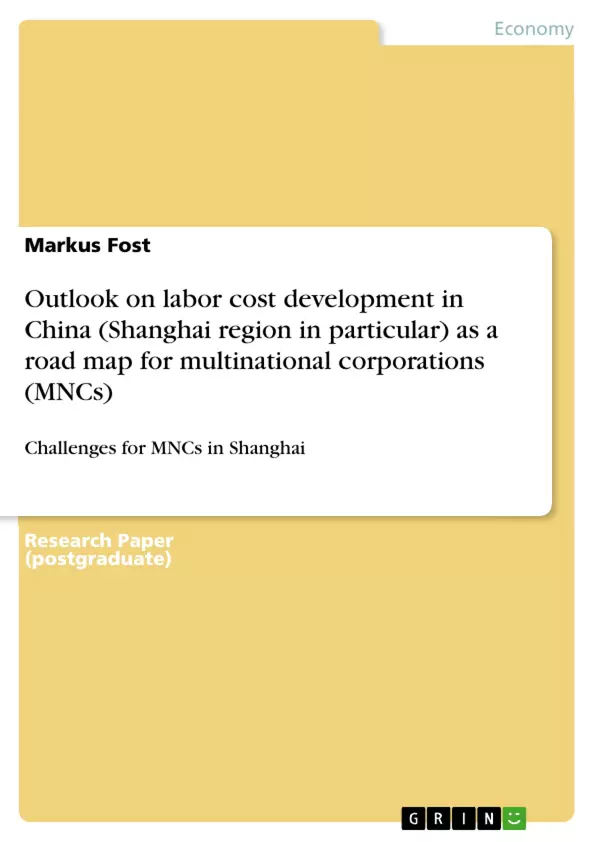Many observers, business people and in particular investors see labor cost developments in China as one of the main challenges for their Chinese subsidiaries. Especially in the East-coast region around Shanghai, labor cost has risen significantly within the last decade. For investors having subsidiaries in this region, the outlook on labor market might not look much brighter than it used to.
Nevertheless, this development results from the impressive shift China has made in such a short period of time. China is now undergoing one of the most massive urbanizations in human history, which becomes nowhere more evident than in Shanghai. The population of this city is officially by now almost 24 million and is forecasted to rise to 30 million by 2020.
Consequently, especially low-tech manufacturing plants in the Shanghai region suffer on the one hand from increasing labor cost, on the other hand from the fact that the government changed its focus to higher value-added industries with less pollution output in order to increase the living standard and quality of the population. In general, this trend means that Shanghai attracts high value-added industries such as Finance and Technology since the city offers well educated workforce as well as for sure an amazing flair attracting multinational corporations (MNC).
The aim of this assignment is to give a precise short-term outlook on the labor cost development in China, which can be used by (potential) investors or MNCs having their subsidiary in the country. This short-term outlook will be extended by a mid and long-term prognosis, taking into account different regional wage developments as well as the macroeconomic performance of China. The prognosis should give the previously described target group a valid document for further planning matters.
Inhaltsverzeichnis (Table of Contents)
- Preface
- Problem statement
- Objective
- Research background / methodology
- Status quo of general labor cost conditions (2011)
- Average wage development within China
- Minimum wage rates within China in 2012
- Government issued wage guidelines 2012
- Unionization and collective bargaining
- Inflation
- Short-term outlook on labor cost development (2012-2013)
- National wage levels
- Regional comparison
- Wage situation by company size and business purpose
- Wage situation by industry
- Mid-term prognosis on labor cost development (FC 2015)
- National wage levels
- Regional comparison – base case
- Regional comparison – moderate growth scenario
- Regional comparison – slow growth scenario
- Challenges for multinational corporations (MNCs) in Shanghai
- Urban development of Shanghai
- Compensation of increasing labor cost with higher productivity
- Westward migration of MNCs
- Critical appraisal and outlook
Zielsetzung und Themenschwerpunkte (Objectives and Key Themes)
This document examines the labor cost development in China, particularly focusing on the Shanghai region. It aims to provide a comprehensive analysis and outlook for multinational corporations (MNCs) operating in the region. The text explores the status quo, short-term and mid-term projections of labor costs, and their implications for MNCs. It also analyzes the urban development of Shanghai and its impact on labor cost trends.
- Labor cost development in China
- Challenges for MNCs in Shanghai
- Urbanization and its impact on labor costs
- Wage trends and projections
- Strategies for MNCs in a changing labor landscape
Zusammenfassung der Kapitel (Chapter Summaries)
The preface introduces the problem statement, which focuses on the increasing labor costs in China and their impact on MNCs operating in the Shanghai region. It also outlines the study's objectives and methodology. Chapter 2 provides a snapshot of the general labor cost conditions in China during 2011. This includes analysis of average wage development, minimum wage rates, government wage guidelines, unionization, and inflation. Chapter 3 focuses on the short-term outlook for labor cost development in 2012-2013. It examines national wage levels, regional variations, and the wage situation based on company size, business purpose, and industry. Chapter 4 offers a mid-term prognosis for labor cost development up to the fiscal year 2015. This includes projections for national wage levels and regional comparisons across different growth scenarios. Finally, Chapter 5 delves into the challenges faced by MNCs in Shanghai, including urban development, the need for higher productivity to compensate for increasing labor costs, and the potential for westward migration of MNCs.
Schlüsselwörter (Keywords)
The key terms and concepts explored in this document include: labor cost development, China, Shanghai, multinational corporations (MNCs), urban development, wage trends, projections, challenges, strategies, productivity, and westward migration.
- Quote paper
- B.A. Markus Fost (Author), 2013, Outlook on labor cost development in China (Shanghai region in particular) as a road map for multinational corporations (MNCs), Munich, GRIN Verlag, https://www.grin.com/document/211216



